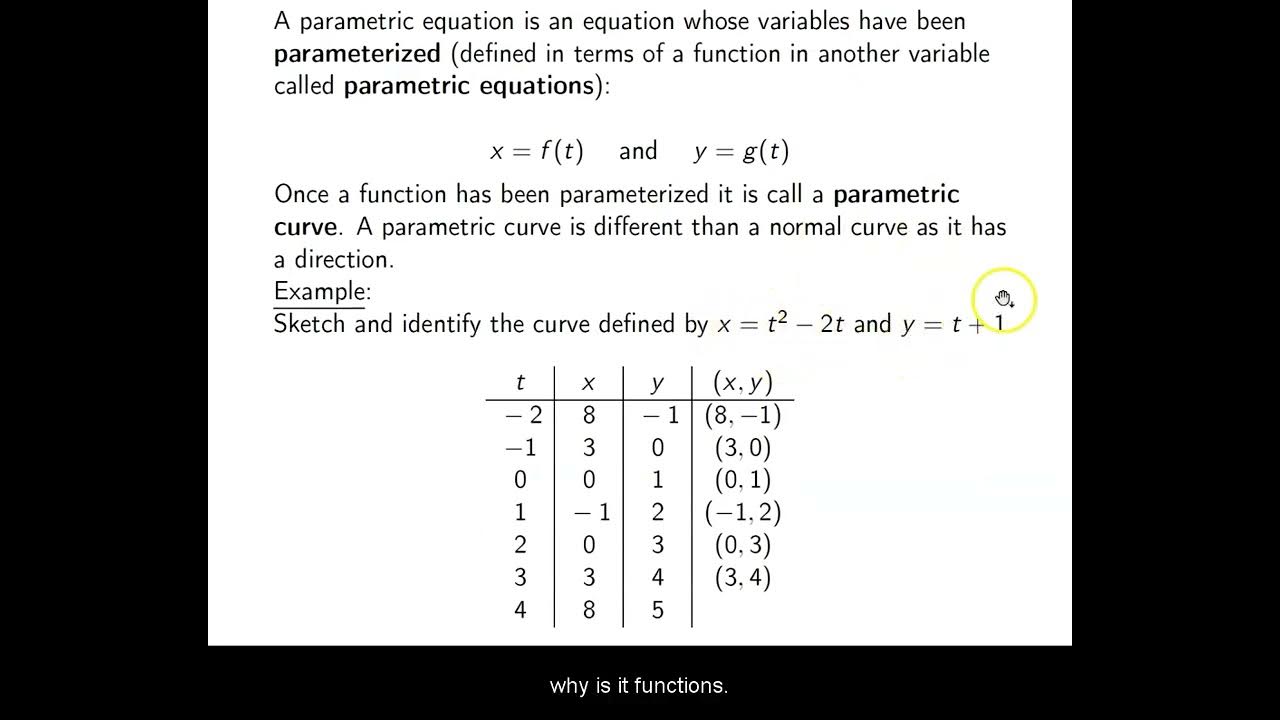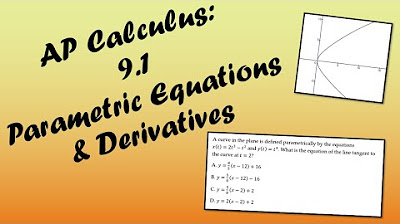Parametric equations 2 | Parametric equations and polar coordinates | Precalculus | Khan Academy
TLDRThe video script discusses the concept of parametric equations by using an example of a car falling off a cliff. It begins with the equations x(t) = 10 + 5t and y(t) = 50 - 5t^2, plotting points to visualize the car's trajectory. The script then explains that these equations describe a continuous curve in both directions, not just the car's fall. It shows how to find the car's path by bounding the parametric equations between t=0 and t=√10, the point where the car hits the ground. The video also demonstrates converting parametric equations into a single equation y = -x^2/5 + 4x + 30, highlighting the loss of directional and temporal information in the process. This example illustrates the utility of parametric equations in capturing more than just the shape of a path.
Takeaways
- 🚗 The script discusses a parametric equation describing the trajectory of a car falling off a cliff.
- 📈 The parametric equations given are \( x(t) = 10 + 5t \) and \( y(t) = 50 - 5t^2 \), representing the position of the car over time.
- 📍 The initial position of the car at \( t = 0 \) is at the point (10, 50).
- 🔢 The script illustrates how to plot points for different values of \( t \) to visualize the path of the car.
- 🔁 The parametric equations describe a continuous curve in both directions, not just the part where the car is falling.
- 🕒 The car's path is bounded by \( t \geq 0 \) and \( t < \sqrt{10} \), representing the time from the car leaving the cliff to hitting the ground.
- 🔍 To find when the car hits the ground (\( y = 0 \)), the script solves for \( t \) in the equation \( 0 = 50 - 5t^2 \), resulting in \( t = \sqrt{10} \).
- 📉 The script explains the process of converting parametric equations into a single equation where \( y \) is a function of \( x \).
- 📚 The resulting equation \( y = -\frac{1}{5}x^2 + 4x + 30 \) represents the same curve but without the time component.
- 🕵️♂️ While the single equation is simpler, it loses information about the direction of motion and specific positions at given times.
- 📝 The script emphasizes the usefulness of parametric equations for conveying complete information about an object's path over time.
Q & A
What is the purpose of using parametric equations to describe the position of a car as it falls off a cliff?
-Parametric equations are used to describe the position of a car as it falls off a cliff to map the car's trajectory over time. They allow for a detailed description of the path, including direction and speed, which can be crucial for understanding the dynamics of the fall.
What are the parametric equations given for the car's position in the video?
-The parametric equations given are x(t) = 10 + 5t for the horizontal position and y(t) = 50 - 5t^2 for the vertical position, where t represents time.
How does the graph of the parametric equations look like?
-The graph of the parametric equations resembles a parabola that opens downwards, with the car's path being a subset of this curve depending on the time interval considered.
What is the significance of the point (10, 50) in the context of the parametric equations?
-The point (10, 50) is significant because it represents the initial position of the car at time t = 0, which is the starting point of the car's trajectory as it falls off the cliff.
How does the car's trajectory change as time t increases?
-As time t increases, the car's trajectory follows the parabola described by the parametric equations. The car moves along the curve, starting from the initial point and descending towards the ground as t approaches the square root of 10.
What happens when the car hits the ground in terms of the parametric equations?
-When the car hits the ground, the value of y becomes 0. This occurs at a time t equal to the square root of 10, as determined by solving the equation 0 = 50 - 5t^2.
Why is it useful to bound the parametric equation to certain values of t?
-Bounding the parametric equation to certain values of t is useful because it allows us to focus on a specific segment of the trajectory, such as the time from when the car leaves the cliff to when it hits the ground. This can simplify analysis and provide clarity on the object's movement within a particular time frame.
Can the parametric equations be expressed as a single equation with y as a function of x?
-Yes, the parametric equations can be simplified to a single equation with y as a function of x by solving for t in one of the equations and substituting it into the other. However, this process can result in a loss of information about the direction and timing of the object's movement.
What information is lost when transitioning from parametric equations to a single equation with y as a function of x?
-When transitioning from parametric equations to a single equation, information about the direction of the object's movement and its position at specific times is lost. The single equation only describes the shape of the path without detailing the temporal aspects of the motion.
Why might one choose to use parametric equations over a single equation with y as a function of x?
-One might choose to use parametric equations over a single equation with y as a function of x because parametric equations provide a more comprehensive description of the motion, including direction and timing. This is particularly useful in scenarios where understanding the dynamics of the movement over time is important.
What is the final simplified equation that represents the path of the car, with y as a function of x?
-The final simplified equation, representing the path of the car with y as a function of x, is y = -x^2/5 + 4x + 30.
Outlines
🚗 Parametric Equations for a Car's Trajectory
This paragraph discusses the use of parametric equations to describe the trajectory of a car falling off a cliff. The equations given are x(t) = 10 + 5t for the horizontal position and y(t) = 50 - 5t^2 for the vertical position. The graph of these equations is a parabola, and the car's path is a subset of this curve, starting from t=0 and ending when the car hits the ground (y=0). The t-value at which the car hits the ground is calculated to be t = √10, which is approximately 3.16. The importance of bounding the parametric equations to describe the car's actual path is emphasized.
📚 Converting Parametric to Cartesian Equations
The second paragraph explores the conversion of the parametric equations from the first paragraph into a single Cartesian equation. The process involves solving for the parameter t in terms of x, and then substituting it back into the y equation. After algebraic manipulation, the resulting Cartesian equation is y = -x^2/5 + 4x + 30, which describes a downward-opening parabola. The paragraph highlights the loss of directional and temporal information when moving from parametric to Cartesian form, emphasizing that while the Cartesian form is simpler for graphing, it does not convey how the object moves over time or its position at a specific time interval.
Mindmap
Keywords
💡Parametric equations
💡Position
💡Cliff
💡Graph
💡Curve
💡T
💡Boundaries
💡Altitude
💡Square root
💡Normal equation
💡Information loss
Highlights
Parametric equations are used to describe the position of a car as it falls off a cliff.
The parametric equations are x(t) = 10 + 5t and y(t) = 50 - 5t^2.
The graph of the parametric equations is a parabola representing the car's path.
The parametric equations describe a curve that extends in both directions indefinitely.
The car's path is a subset of the entire curve described by the parametric equations.
The car's path is bounded by t = 0 when the car leaves the cliff and t = √10 when it hits the ground.
The value of t that makes y = 0 is found by solving 0 = 50 - 5t^2, resulting in t = √10.
Parametric equations can be bounded for specific values of t to describe a particular path.
Converting parametric equations to a single equation y(x) or x(y) loses information about the direction and time-based movement.
The single equation y = -x^2/5 + 4x + 30 is derived from the parametric equations but does not include time information.
Parametric equations are useful for providing detailed information about an object's path over time.
The single equation y(x) or x(y) can describe the shape of a path but not the temporal aspects.
The parametric form retains information about the object's position at specific times, which is lost in the single equation form.
The example demonstrates the conversion of parametric equations to a single equation and the trade-offs involved.
Understanding the limitations of single equations derived from parametric equations is crucial for accurate modeling.
Parametric equations provide a more comprehensive description of an object's motion, including direction and time.
The video concludes with a reminder of the importance of parametric equations in capturing the full details of a path.
Transcripts
Browse More Related Video

Parametric equations 1 | Parametric equations and polar coordinates | Precalculus | Khan Academy

Parametric equations 3 | Parametric equations and polar coordinates | Precalculus | Khan Academy

Ch. 8.4 Plane Curves and Parametric Equations

Parametric Equations

AP Calculus BC Lesson 9.1

Calculus 2 Lecture 10.2: Introduction to Parametric Equations
5.0 / 5 (0 votes)
Thanks for rating: